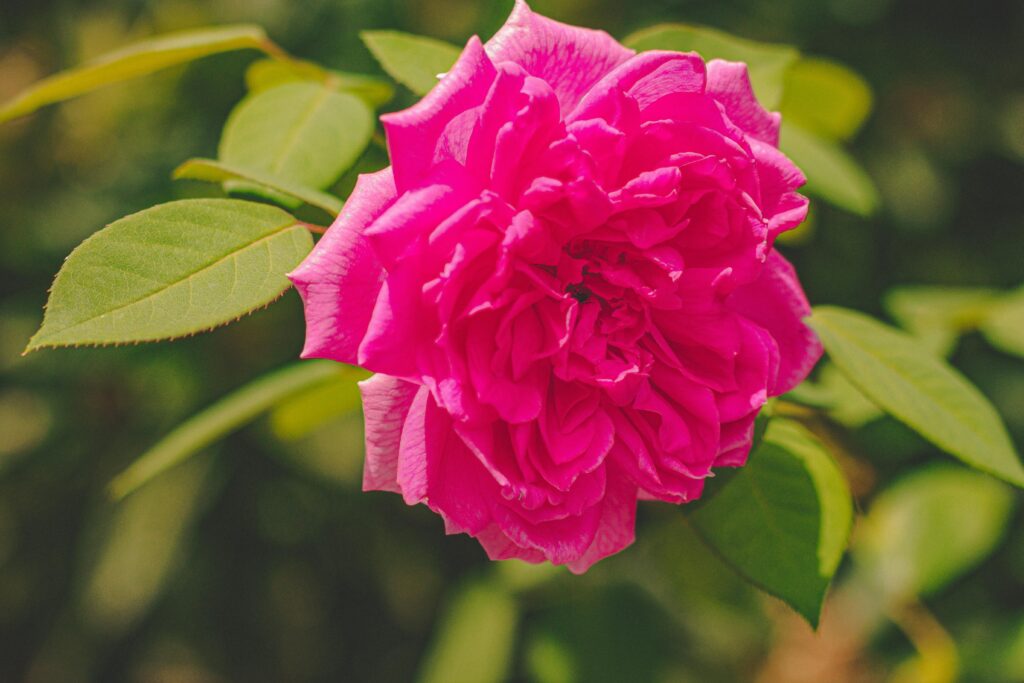
Rose essential oil, often called “liquid gold” in the world of aromatherapy, is one of the most precious and revered essential oils. Its exquisite fragrance and wide-ranging therapeutic properties make it a staple in high-end perfumery, skincare, and holistic wellness. However, few people realize the incredible labor, botanical specificity, and scientific richness behind each drop of this luxurious oil.
Origins and Types of Roses Used
Rose essential oil is primarily distilled from the petals of the Damask rose (Rosa damascena), and less commonly from the Cabbage rose (Rosa centifolia). The Damask rose is the preferred variety due to its superior aromatic and therapeutic qualities.
Primary Growing Regions:
- Bulgaria (notably the Rose Valley near Kazanlak) – considered the gold standard in rose oil production.
- Turkey – especially the Isparta region.
- Iran, India, and Morocco also cultivate roses for essential oil but with varying chemical profiles.
Production: From Petals to Precious Oil
Producing rose essential oil is an incredibly labor-intensive process. It takes an astonishing 10,000 pounds (approximately 5 tons) of fresh rose petals to yield just 1 pound (16 oz) of rose essential oil. To break it down further:
- It takes approximately 60 roses to make 1 drop of rose essential oil.
- Harvesting must occur early in the morning, typically before sunrise, when the oil concentration is at its peak.
- Steam distillation is the traditional method, although rose absolute (a solvent-extracted product) is also popular for perfumery.
This low yield and high labor cost contribute to the oil’s steep price, often ranging from $200 to $700+ per ounce, depending on purity and origin.
Chemical Composition and Therapeutic Attributes
The therapeutic power of rose essential oil comes from its rich chemical profile. Key constituents include:
- Citronellol – Antibacterial, anti-inflammatory
- Geraniol – Antiviral, antioxidant
- Nerol – Antimicrobial, calming
- Phenylethyl alcohol – Floral scent, mood-elevating
- Eugenol (trace) – Slightly analgesic
These compounds give rose oil a broad range of therapeutic properties, including:
- Emotional balance: Reduces anxiety, depression, and stress.
- Skin health: Supports cellular regeneration, balances moisture, and soothes inflammation—ideal for mature or sensitive skin.
- Aphrodisiac effects: Historically used to enhance intimacy and emotional connection.
- Antimicrobial and antioxidant: Useful in natural skin formulations and healing balms.
Typical Uses and Blend Suggestions
Rose essential oil is both versatile and potent. It should be diluted properly, typically at 1% or less in carrier oils.
Popular Applications:
- Skincare: Add to facial serums, creams, or masks for anti-aging and anti-inflammatory benefits.
- Aromatherapy: Diffuse to alleviate emotional stress and lift the mood.
- Massage oil: Blend with carrier oils like jojoba or sweet almond for emotional and sensual relaxation.
- Bath: Mix with Epsom salts and carrier oil for a calming soak.
Blend Ideas:
- For Emotional Balance
- Rose + Bergamot + Frankincense
- For Skincare (Anti-aging Serum)
- Rose + Helichrysum + Lavender + Rosehip oil (carrier)
- For Romance
- Rose + Sandalwood + Ylang Ylang
Cost and the Importance of GC/MS Testing
Due to the high cost and limited availability of authentic rose oil, adulteration is common. Cheaper oils may be diluted with synthetic components or less expensive floral oils. This not only reduces therapeutic value but can cause allergic reactions or skin irritation.
Why GC/MS Reports Matter:
A Gas Chromatography/Mass Spectrometry (GC/MS) report provides a detailed chemical analysis of the oil. This:
- Confirms authenticity and purity.
- Identifies adulterants or synthetic additives.
- Helps aromatherapists tailor therapeutic use based on chemical constituents.
Always request or verify a GC/MS report when purchasing rose essential oil from a reputable supplier.
Conclusion
Rose essential oil is more than a luxury—it’s a potent therapeutic ally derived from centuries of tradition and backed by modern science. Whether used for skincare, emotional support, or romantic blends, its value lies not only in its aroma but in the care required to produce it. By understanding its origins, composition, and proper usage, you can fully appreciate and harness the power of this botanical treasure.
